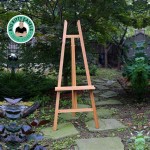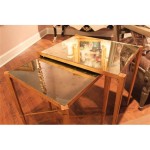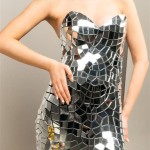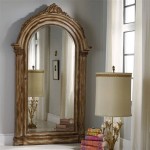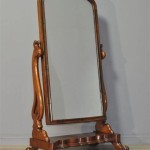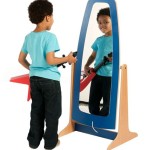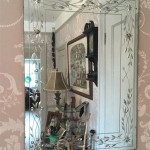How to Mount a Large Bathroom Mirror Securely
Mounting a large, heavy bathroom mirror requires careful planning and execution to ensure safety and longevity. This process differs significantly from hanging smaller, lighter mirrors and necessitates specific tools and techniques. This guide provides a comprehensive overview of how to safely and effectively mount a large bathroom mirror.
Assessing the Mirror and Wall
Before initiating the mounting process, careful assessment of both the mirror and the wall is crucial. This preliminary step informs material selection and mounting method decisions.
- Mirror Weight and Dimensions: Accurately measure the mirror's dimensions and determine its weight. This information is essential for selecting appropriate mounting hardware and ensuring the chosen method can support the mirror's weight.
- Wall Type: Identify the wall material (drywall, plaster, concrete, etc.). Different wall types require different mounting hardware and techniques. Drywall, for example, might necessitate the use of wall anchors, while concrete requires specialized anchors and drill bits.
- Stud Location: Locate and mark the wall studs using a stud finder. Mounting into studs provides the most secure support for heavy mirrors, especially in areas prone to humidity and temperature fluctuations.
Selecting the Appropriate Mounting Hardware
The correct mounting hardware is critical for a secure and stable installation. The choice depends primarily on the mirror's weight and the wall type.
- J-Clips: J-clips are commonly used for heavier mirrors and offer excellent support. They are installed on the wall and the mirror rests within the "J" shape.
- Z-Clips/French Cleats: Z-clips, also known as French cleats, provide a robust mounting solution for large, heavy mirrors. One part of the clip is attached to the wall, and the other to the back of the mirror; the two interlock for a secure hold.
- Mirror Adhesive: For lighter mirrors or as supplementary support, mirror adhesive can be used in conjunction with other hardware. It's crucial to choose an adhesive specifically designed for mirrors to prevent damage to the backing.
- Heavy-Duty Screws and Anchors: When mounting into studs, use heavy-duty screws appropriate for the wall type. For drywall or plaster that isn't directly over a stud, use appropriate wall anchors, such as toggle bolts or molly bolts, to provide adequate support.
Preparing the Wall and Mirror
Proper preparation ensures a smooth and secure mounting process.
- Marking the Mounting Points: Carefully mark the desired mirror location on the wall and indicate the positions for the mounting hardware. Use a level to ensure the markings are perfectly horizontal.
- Pre-Drilling Pilot Holes: Pre-drilling pilot holes is crucial, especially when working with harder wall materials like concrete. This prevents cracking and ensures accurate placement of screws and anchors.
- Attaching Mounting Hardware to the Mirror: Carefully attach the appropriate mounting hardware to the back of the mirror according to the manufacturer's instructions. Ensure the hardware is securely affixed and evenly spaced.
Mounting the Mirror
Mounting the mirror requires precision and care to avoid damage and ensure secure placement.
- Enlisting Assistance: For large, heavy mirrors, having a helper is highly recommended. This ensures the mirror is positioned correctly and prevents accidental drops.
- Careful Alignment: Align the mirror's mounting hardware with the corresponding points on the wall. Gently and securely engage the mounting hardware.
- Final Adjustments and Securing: Make any necessary adjustments to ensure the mirror is level and plumb. Tighten screws or bolts securely, taking care not to overtighten, which could damage the mirror or the wall.
Post-Installation Considerations
After the mirror is mounted, a few final steps complete the installation.
- Cleaning: Clean the mirror surface with a suitable glass cleaner.
- Sealant Application (Optional): Applying a bead of sealant around the edges of the mirror where it meets the wall can prevent moisture from seeping behind the mirror. Ensure the sealant is compatible with both the mirror and the wall material.
Safety Precautions
Safety should always be a top priority when undertaking this project.
- Eye Protection: Always wear safety glasses when drilling and working with mounting hardware to protect your eyes from dust and debris.
- Proper Lifting Techniques: When lifting a heavy mirror, use proper lifting techniques to avoid back strain. Bend at your knees, not your waist, and keep the mirror close to your body.
- Work Gloves: Wearing work gloves provides a better grip and protects hands from sharp edges and potential injuries.

How To Hang A Heavy Mirror Diy Family Handyman
:max_bytes(150000):strip_icc()/midcentury-bathroom-5a1f3dfb4e46ba001aa8b230.jpg?strip=all)
13 Beautiful Mirrored Bathrooms

How High Should You Hang The Mirror In A Bathroom With Photos Design Morsels

Upiker 36 In W X H Large Square Frameless Anti Fog Ceiling Wall Mount Bathroom Vanity Mirror Silver Up2209mirs3636 The Home Depot

36 X 24 Inches Large Bathroom Makeup Mirror Modern Rectangle Black Wall Mounted With Aluminum Frame Vertical Or Horizontal Hanging Decorative Mirrors For Vanity Living Room Bedroom Com

Upiker 48 In W X 32 H Large Rectangular Frameless Anti Fog Ceiling Wall Mount Bathroom Vanity Mirror Silver Up2209mirs4832 The Home Depot

1400x800mm Large Bathroom Mirrors With Led Lights Illuminated Backlit Wall Mount Light Up Mirror Dimmable Switch Horizontal Vertical Heated Pad Demister Acezanble

Blanca Led Bathroom Mirror Large Size Rectangular Anti Fog Memory Dimmable Touch Sensor Horizontal Vertical White Daylight Lights The Pop Home Target

Frameless Living Room Decoration Mirrors Modern Sun Home Decor Large Wall Mount Bathroom Heteromorphic Mirror China Smart Made In Com

Epowp Xylbg 3224 O Large Oval Frameless Anti Fog With Led Light Wall Mount Bathroom Vanity Mirror Installation Guide

